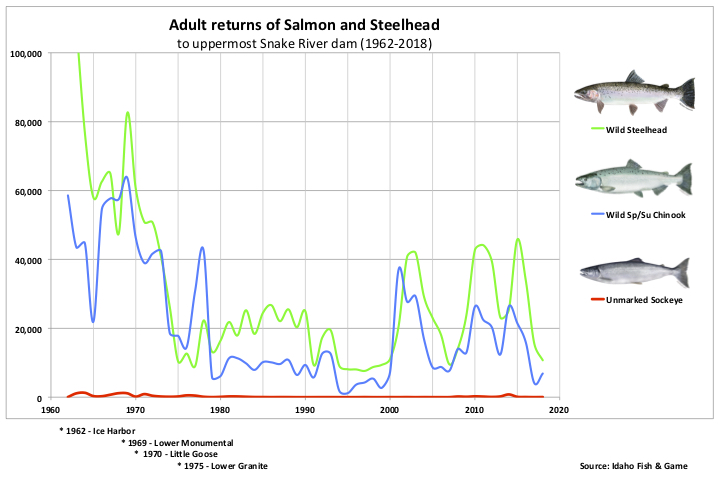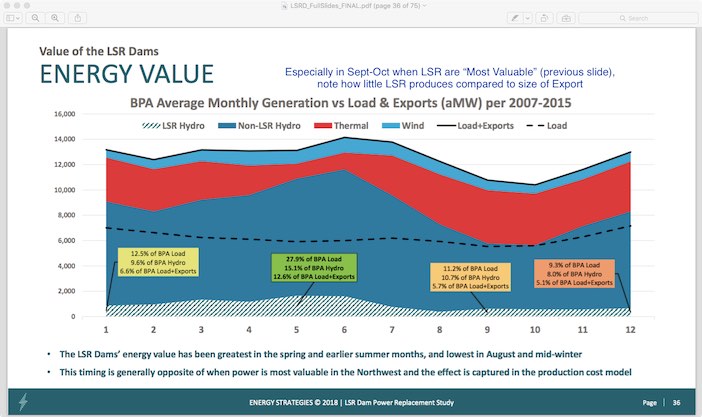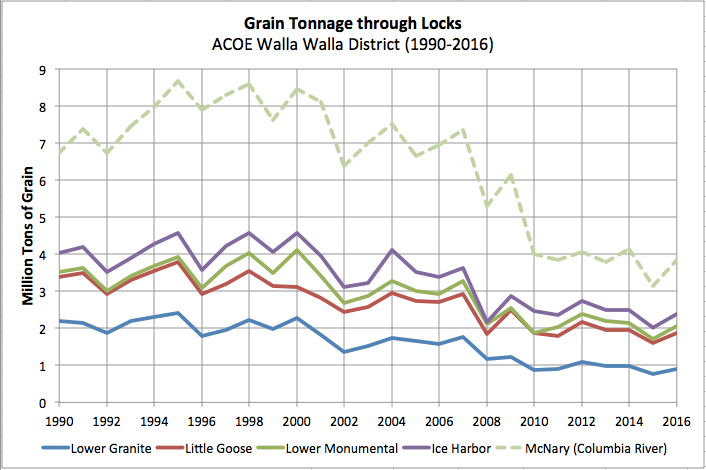forum
library
tutorial
contact

Salmon Runs in 2019 Expected
to Be Lower Than 2017, 2018
by Xavier Ward
Boise Weekly, August 7, 2019
|
the film forum library tutorial contact |

|
Salmon Runs in 2019 Expected
by Xavier Ward
|
The final piece in a series exploring dam removal and salmon conservation on the Lower Snake River
 New numbers from Idaho Fish and Game show that sockeye salmon returns are at their lowest in a decade.
New numbers from Idaho Fish and Game show that sockeye salmon returns are at their lowest in a decade.
Only 53 fish have crossed the final dam on the Lower Snake River, which is fewer fish than both 2018 and 2017 at this time. At 228 sockeye returns, 2017 saw the lowest rate of fish returning to their spawning grounds in more than a decade, Fish and Game numbers show.
Millions of federal dollars go to salmon conservation issues every year, while arguments about how to actually save the salmon continues to unfurl. Whether to breach the four dams on the Lower Snake River is the subject of much of that debate, and central to that is the economics of dam removal.
Conservationists argue the dams are the main, but not sole, impediment to the salmonids' journey home, but those with an interest in keeping the dams hope to find ways to restore salmon populations without pulling out the federally owned hydropower dams. The dams are operated by the Bonneville Power Administration, a federal entity.
One of the biggest questions for those involved is how much economic value the dams actually provide, and how do the fish stack up to that value?
According to a report by ECONorthwest, an economic consulting firm based in Washington, pulling out the dams makes economic sense. Others who are in favor of keeping the dams, however, are not convinced by the results of the report.
"We started working on this more than a year and a half ago, and we were charged with a broad look at the economic value of taking out the dams," said Adam Domanski, the project manager and author of the report.
 His conclusion: "Society would be better off."
His conclusion: "Society would be better off."
According to the report, removing the dams would amount to an $8.65 billion value increase to the area. While there are costs associated with grid upgrades, the overall economic impact would be positive. The cost of removing the dams is estimated at $1.08 billion, while the cost of grid upgrades is right around $2.21 billion. There would also be some additional costs for irrigation.
However, stacked up with the nearly $11 billion added from non-use values and $1 billion extra in recreation opportunities, removing the dams is estimated to be a net positive, according to the report. Non-use values are an economic value showing the cost of something if it is not used. It is a common measurement in the valuation of natural resources.
Domanski said the report is a comprehensive, unbiased approach to looking at dam breaching. He noted that the researchers considered all potentially impacted parties including farmers, irrigators and grain shippers.
'This isn't an advocacy piece. This was objective research," Domanski said. "We are trying to look at the broad lens, holistic view."
Others who have a vested interest in keeping the dams question the outcome of the study.
"The report falsely suggests that this complex challenge of reconciling the need for the dams and protecting our iconic salmon can be easily resolved," Pacific Northwest Waterways Association Executive Director Kristin Meira wrote. "In fact, the path it recommends would devastate towns, businesses and families in southeast Washington, northern Idaho and much of the rural Northwest."
Meira went on to write that the report mischaracterizes the benefit to small communities in the Pacific Northwest by assuming jobs would be created through dam removal.
 The Lower Snake and Columbia rivers are undoubtedly economic assets for grain farmers in the area. In fact, 53% of all U.S. wheat makes its way down the Columbia River, and the Lower Snake River accounts for 10% of all U.S. wheat shipments. Removing the dams would lower the river levels to the point where barges could no longer ship grain down the river.
The Lower Snake and Columbia rivers are undoubtedly economic assets for grain farmers in the area. In fact, 53% of all U.S. wheat makes its way down the Columbia River, and the Lower Snake River accounts for 10% of all U.S. wheat shipments. Removing the dams would lower the river levels to the point where barges could no longer ship grain down the river.
Additionally, the dams provide power for the area. While conservationists argue that the amount of power produced by the four Lower Snake River Dams could easily be replaced with other renewable sources such as wind or solar, small communities throughout the Pacific Northwest use the power produced by the dams.
"The concerns are large and wide. The four Lower Snake dams at capacity can provide over 3,000 megawatts," said Will Hart, executive director of Idaho Consumer-Owned Utilities Association. His organization represents power users in 22 small Idaho cities, selling them power at cost. Power from the Bonneville Power Administration makes up 96% of all utilities provided to the small rural communities, Hart said.
Taking the dams offline would hurt the Bonneville Power Administration, therein hurting the power users represented by Hart's organization.
"For us, that would translate definitely to rate increases," Hart said.
The economic study from ECONorthwest was not the kind of evidence Hart wants to see in the conversation of saving the salmon from extinction. Hart is a member of Gov. Brad Little's Salmon Workgroup, and he hopes to come up with a solution that helps increase salmon population numbers to a sustainable level without injuring local power users. To date, there has been little objective evidence that the dams are actually hurting the salmon, he believes.
"There's science and there's facts, then there's advocacy science and advocacy facts," he said.
The federal government will release an environmental impact statement regarding the dams in the coming months, which Hart said he believes will help set the record straight.
In the meantime, Hart hopes to keep working toward Idaho solutions to save the state's legacy fish.
"I think there's a lot of good we can potentially do around the table together," he said.
EDITOR'S NOTE: An earlier article in this series falsely stated the amount of wheat shipped down the Columbia River. The total amount of wheat shipped down the Columbia is 53% of U.S. wheat, while 10% of U.S. wheat makes its way down the Lower Snake River.
Related Pages:
Study: Breaching Dams Would Pay Off by Eric Barker, Lewiston Tribune, 7/31/19
Bonneville Power Administration Faces Promise and Perils in Changing Energy Markets by Hal Bernton, Seattle Times, 7/21/19
learn more on topics covered in the film
see the video
read the script
learn the songs
discussion forum
